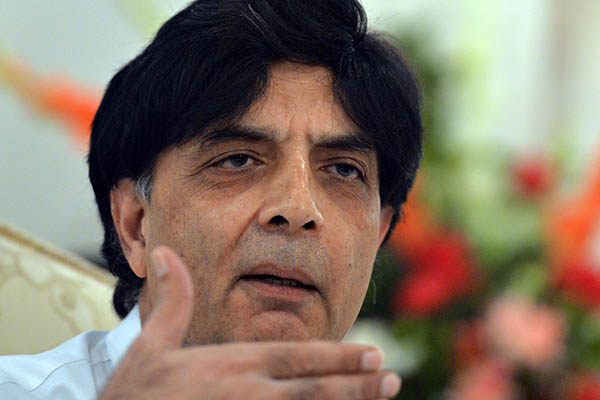
Aamir Qureshi—AFP
Some quick thoughts on Chaudhry Nisar Ali Khan’s press conference and the Supreme Court’s impending Panama verdict
Chaudhry Nisar Ali Khan, interior minister and one of the senior-most leaders of Pakistan Muslim League (Nawaz), has spoken. It was delayed by several days but threw light on some very important issues.
Khan made clear that Pakistan is facing major national security threats. He talked about five people who know what’s happening. That includes two civilians, two Army officers and he himself. He did not elaborate on the nature of the threats except that Pakistan is being besieged. One can assume that he was referring not just to acts of terrorism but also a concerted effort by some external state actors to put Pakistan in the doghouse.
He mentioned civil-military relations and his between-the-lines narrative did not provide an okay report. It was clear that the khakis and the muftis are not in harmony. This is not entirely surprising, even though, unlike during General Raheel Sharif’s tenure, Inter-Services Public Relations has been generally less intrusive if one discounts that one abrasive tweet about the Dawn leak issue.
The third issue that Khan addressed related not only to his own decision to step aside but also linked up with civil-military tensions: the presence in the party of someone who is taking decisions that Khan did not and does not think to be of any advantage either to the party or the government or, given various threats, the country. These decisions, according to Khan’s narrative, have a clear bias against the military and have led to unnecessary confrontation. Please note that Khan used his words very carefully and for the most part rested his case on between-the-lines inferences.
In the event, as he said, he is done with politics, is not going to contest 2018 polls and regardless of what the Supreme Court of Pakistan decides in the Panama case, following the JIT report, he shall resign as a minister and as an MNA.
So, what does one make of this?
Much of what Khan said has been known to varying degrees. For instance, the fact that the prime minister and Khan do not see eye to eye is not a problem spanning the last two months or so. It is much older. Khan’s assertion about civil-military imbalance is also a fact about which there’s much nuts-and-bolts information. That the PMLN media cell, which is run by the prime minister’s daughter, who is unelected but wields much behind-the-scenes influence, is also known. So, what’s new?
Khan’s narrative. It is one thing for reporters and analysts to pick up the spoor and file stories or write analyses. Quite another when someone as senior as Khan organizes a press conference and begins connecting dots. In other words, Khan today put together the various pieces of the mosaic held by many reporters and analysts.
In all of this comes news that the Supreme Court will deliver its verdict at 1130 hours tomorrow, a story first broken by this magazine earlier today. The court roster indicates that the bench will not consist of three but five judges, including the two who have already disqualified the prime minister. There’s much controversy in legal circles on this issue. While many jurists think that the two judges who have already given the disqualification verdict cannot be on the bench because they can add nothing to what they already ordered, some others think that the 3-judge bench was only for implementation and the final decision has to be made by the original 5-member bench.
This doesn’t sit well with commonsensical logic but that’s how it’s going to be tomorrow, given what the court roster says.
The Pakistan Tehreek-e-Insaf has already declared that the jig is up for the prime minister. That seems to be the dominant sentiment. And while sources in the PMLN say they would not like to prejudge, they are clearly worried. Interior Minister Khan’s words that the prime minister should keep his cool whether he wins or loses appear to be ominous, as is the 5- instead of 3-member bench. Since two judges have already disqualified the P.M., it will take just one more to send the P.M. home.
Does Khan fear that or knows that? Has he jumped ship just in time, his spiel about grievances notwithstanding? Has the ‘establishment’ struck back to punish the PMLN for being brash? Will this be the beginning of the internal break-up of the party? How will the PMLN react? Will it call early elections? Will it replace Sharif with someone else? Will this induce stability or bring greater instability—especially at a time when, as Khan indicated, the country is facing existential threats as severe as the time when East Pakistan seceded, possibly worse?
These are questions one can only speculate about. What is clear at this stage is what Khan said: he will resign after the SC decision. So, today was his last day as interior minister and an MNA. The second certainty: whatever happens, instability is not something this country can afford, definitely not at this point.
Haider is editor of national-security affairs at Capital TV. He was a Ford Scholar at the Program in Arms Control, Disarmament and International Security at the University of Illinois at Urbana-Champaign, and a visiting fellow at the Brookings Institution, Washington, D.C. He tweets @ejazhaider

3 comments
“instability is not something this country can afford, definitely not at this point.”
What more worse of instability are we expecting after panama verdict comes?
And who else but the army will be responsible for that.
WHY INDIA FEARS NAWAZ OUSTER